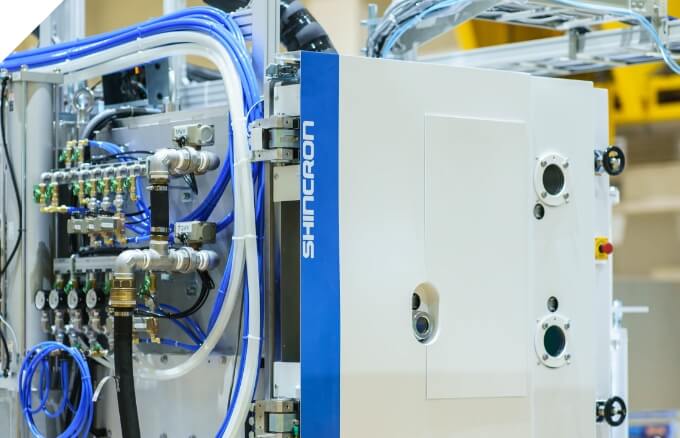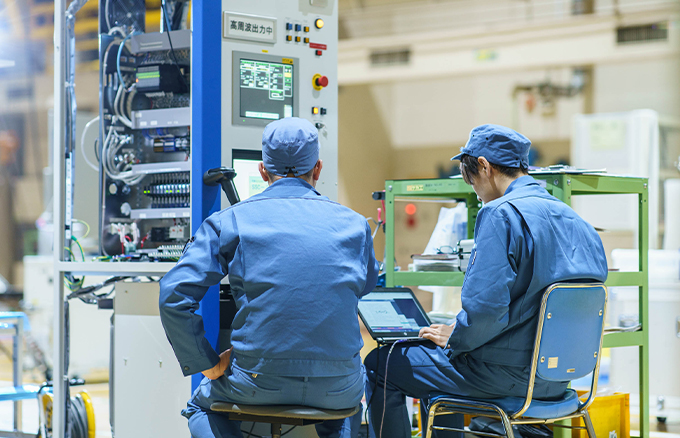2. History of thin film deposition using vacuum
First, the history of vacuum and thin film formation is looked back on here.5)
The discovery of a sputtering phenomenon (as described later) by W. R. Grove in 1852 is said to have revealed that thin films are formed in vacuum for the first time. However, this discovery was the finding of a phenomenon where a cathode that is sputtered and scraped in a vacuum discharge tube soils the tube wall, but it was not intended to form a thin film. Since then, how to decrease the sputtering phenomenon had been the subject of research and development of discharge tubes. Soon after the discovery by Grove, M. Faraday is said to have tried vacuum deposition (as described later) in 1857. This is said to have been an attempt to form a thin film in an intended manner and the oldest formation of a thin film in vacuum. However, it took time until this method was put to practical use, because the level of vacuum technology was very low at that time. Afterward, a breakthrough was achieved in the 1930s, when vacuum technology advanced drastically, beginning with the completion of a diffusion pump that uses oil as operating liquid (as described later). As a result, vacuum deposition rapidly became a practical technology.
Firstly, antireflective films for lenses, which had been made by a chemical method, began to be formed through vacuum deposition. As a result, optical thin films developed greatly. In particular, antireflection films were absolutely essential in the Second World War, because the transmittance level of optical systems with many lens faces, such as the periscopes of submarines, affected the outcome of the war.
Here, the effects of antireflection films are compared based on their actual reflectance ratios.
As periscopes consist of 15 – 25 lenses and prisms, they have 30 – 50 faces that contact the air and reflect light.
Assuming that a periscope has 30 faces that consist of glass with a refractive index of approximately 1.52, the transmittance of the entire optical system is calculated as follows:
- The case where no antireflective film is formed
- The light volume decreases to 96% every time light passes through a face, because of the reflection due to the difference in diffractive indexes between the air and glass.
- For example, in the case of a camera consisting of 15 lenses, the volume of the light entering an imaging element (CMOS) decreases to 29%.
- In addition, the light reflecting off each face becomes stray light that generates ghosts and flares, and also reduces the image contrast.
- The case where a single-layer antireflection film is formed on each face
- Assume that the transmittance of each single face is 98.7%.
- The volume of the light transmitted after passing 30 faces becomes 67.5%, compared to incident light. The transmittance (transmitted light volume/incident light volume) becomes approximately 2.3 times higher than that of the faces with no antireflection film.
- The case where multi-layer antireflection films are formed
- Assume that the transmittance of each single face is 99.7%.
- The transmittance of the light that enters an imaging element after passing through 30 faces becomes 91.3%.
- And the occurrence of ghosts and flares is reduced because of reduced reflection on each face.
It is apparent that applying antireflection films enhances the performance of the entire optical system.
As optics industries such as cameras grew in postwar Japan, there was much research conducted on antireflection films formed thorough vacuum deposition. In particular, the color television broadcasting of the Tokyo Olympic Games held in 1964 became a major turning point. For achieving the enhancement of the transmittance of TV cameras with complicated lens configurations and the reproduction of natural colors, electronic gun evaporation sources were put to practical use as a result of capital investment, as if in disregard of profits. Finally, multi-layer antireflection films were put to practical use.
Vacuum deposition was used in the electricity and decorative fields, and various application research were conducted as a representative of new technology. Furthermore, as a result of the advancement of vacuum technology, Molecular Beam Epitaxy (MBE) performed in ultra-high vacuum was created, and Ion Plating method was created as a combined technology with plasma.
On the other hand, sputtering, so to speak, had long been a villain in the research conducted to prevent cathodes of discharge tubes from being sputtered and soiling tube walls. The application research for forming thin films using this sputtering phenomenon was conducted mainly in the United States, and this technology started to be widely used as a practical technology after the 1960s. Afterwards, this technology was actively researched, and it is now an extremely important thin film formation technology.
The methods described above are collectively described as the Physical Vapor Deposition (PVD) method, because they are physical methods for evaporating substances that form thin films by heating and for sputtering with the kinetic energy of gas ions. On the other hand, there is a method for forming thin films through a chemical reaction in a reaction container by using compound gases as raw materials. This is called the Chemical Vapor Deposition (CVD) method. Although CVD is said to have been known in principle in the 1930s, it was put to practical use in the late 1950s when a titanium carbide film was formed as an anti-wear material in Germany. In the 1960s, CVD was utilized for the epitaxial growth of semiconductors and became a potent thin film formation technology. Chemical reactions were conducted under atmospheric pressure exclusively using thermal energy during the initial stage, but their use was limited because the substrate temperature was required to be approximately 1,500 °C. Afterwards, a method for conducting chemical reactions under reduced pressures was developed, and the processing temperature was decreased to approximately 800 °C. Speaking about the relationship between CVD and vacuum, CVD was used to exhaust the air from a container into which raw material gases are introduced and vacuumize it in advance to eliminate unnecessary gases during the initial stage. It can be said that CVD under reduced pressures established a closer relationship with vacuum technology. After that, a CVD method using plasma was developed, and the processing temperature was decreased to approximately 300 °C. As a result, it became possible to form films without heating, depending on the film type. Recently, a method for promoting chemical reactions using discharge tubes and lasers has also been used.




